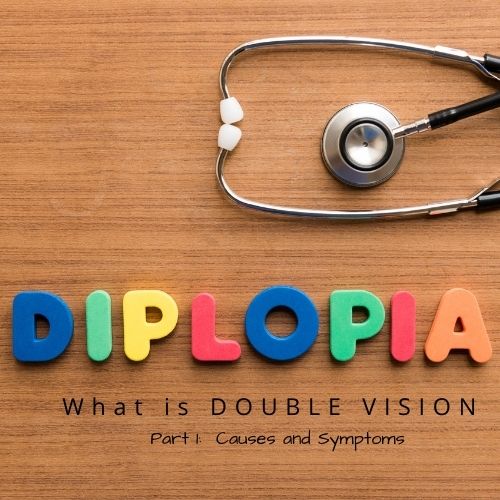Understanding Double Vision | Part 1


This is part 1 of “Understanding Double Vision.” Part 2 – “Diagnosis and Treatment of Double Vision” will follow.
Double vision, known by the medical term diplopia, is seeing two images of a single object adjacent to each other. Those doubled images can be either horizontally, vertically, obliquely or overlapping.
Normal vision requires the coordination of your eyes, the muscles that move your eyes, the nerves that transmit electrical visual signals to your brain, and the visual cortex of your brain.
An episode of diplopia could be caused by an eye nerve or muscle problem. It may be caused by a cataract or by a brain problem such as a stroke.
To find the cause you may need blood tests, imaging tests such as an MRI and you may need to see a neurologist for more testing or treatment. But effective treatment depends on identifying the underlying cause and treating that.
Symptoms
Diplopia can be constant or it can be intermittent. It can occur only with near or far vision. It can be in one eye (monocular) or both eyes (binocular).
Other symptoms that can occur with the double vision are:
- Droopy eyelids
- Headache
- Nausea
- Misalignment of one or both eyes
- Pain around the eye such as the temple or eyebrows
- Pain with eye movements in one or both eyes
If you are seeing double, it is important to seek professional eye care so the underlying cause can be discovered and treated.
Causes of Double Vision
Many conditions can cause you to see double, including problems within the eye, such cornea or lens problems. The muscles or nerves controlling eye function could be the cause or it could be issues in the brain. The causes of diplopia range from minor to life-threatening—such as aneurysm or stroke.
The following are common causes:
Cornea problems: The cornea is the clear layer that covers the front of the eye and its function is to focus incoming light. Cornea problems include:
- Astigmatism
- Dry eyes
- Infections such as shingles or herpes zoster
- Scars caused by disease, injury, or infection.
Lens problems: Your eye’s lenses work with the corneas to focus incoming light onto the retina. The most common lens problem that causes double vision is a cataract.
Eye muscle problems: There are six muscles that control your eye’s up, down, and side-to-side movements. Weakness or paralysis of one of the muscles that prevents one eye from moving in exact coordination with the other.
- Strabismus is a misalignment of the eyes caused by a weakened or paralyzed eye muscle that prevents the eyes from aligning properly. Strabismus usually develops in infants and young children but can also develop in older children and adults. There are many effective treatments for strabismus.
- Graves disease is a thyroid condition that affects eye muscles and causes vertical double vision in which the images appear one on top the other.
Nerve problems: Conditions that can affect or damage the cranial nerves that connect the brain to the eye muscles can cause double vision. Those conditions include:
- Diabetes
- Guillain-Barre syndrome
- Myasthenia gravis
- Multiple sclerosis
Brain problems: Several areas in the brain process visual information. If any of those areas are affected by illness or injury, it can cause double vision. Some brain conditions that can cause double vision are:
- Migraine headache
- Stroke
- Brain aneurysm
- Brain tumor
- Pressure inside the brain from bleeding, infection, or trauma
Note: Some causes of diplopia are temporary and are caused by alcohol intoxication, benzodiazepines, opioids, or certain medications for seizures Head injuries, such as a concussion can also cause temporary double vision.
Extreme fatigue or eye strain can cause a temporary bout of double vision. However, if the double vision persists seek a medical evaluation.
